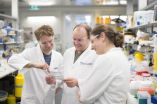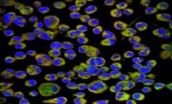(Press-News.org) Cardiovascular disease remains the number one cause of death in the Western world, with heart failure representing the fastest-growing subclass over the past decade. The stage that precedes heart failure in a significant number of cardiovascular diseases is pathological hypertrophy — the growth of the heart muscle in an attempt to increase its output.
Not all hypertrophy is pathological; for example, during pregnancy or high physical exertion, the muscle of the heart grows but myocardial function remains normal. But when hypertrophy is excessive, prolonged and unbalanced, it becomes pathological, leading to heart failure and arrhythmias.
Now for the first time, researchers at the Hebrew University of Jerusalem's Faculty of Medicine have revealed how a protein called Erbin acts as a brake against this excessive and pathological growth of heart muscle. They also demonstrated that damage to this protein leads to excess growth of heart muscle, a decrease in function, and severe pathological growth of heart muscle.
The research was conducted by Ms. Inbal Rachmin as part of her doctoral thesis, under the supervision of Prof. Ehud Razin and Dr. Sagi Tshori at the Institute for Medical Research Israel–Canada in the Faculty of Medicine at the Hebrew University of Jerusalem. The study, "Erbin is a negative modulator of cardiac hypertrophy," was published in the Proceedings of the National Academy of Sciences (PNAS).
Ms. Rachmin detected a significant decrease in the expression of the protein Erbin in the heart tissue of patients suffering from heart failure. Moreover, the induction of hypertrophy in mice lacking Erbin led to the early death all of these mice, compared to only about 30 percent mortality observed in the control group. Histological examination showed that heart failure was the main reason for this.
This important research also has further implications in the area of breast cancer treatment. Erbin interacts with the receptor Her2/ErBb2, which is overexpressed in approximately 30% of breast cancers. The standard treatment in these cases is the use of Herceptin, an antibody to this receptor. Studies have shown that 5-10 percent of breast cancer patients who received this treatment together with chemotherapy have a significant decrease in heart function. The researchers describe a cardioprotective role for Erbin, which suggests it is a potential target for cardiac gene therapy.
INFORMATION:
The study was carried out in close collaboration with the following researchers: Prof. Dan Gilon, Director of the Echocardiography/Non-Invasive Cardiology Unit of The Heart Institute at the Hadassah University Medical Center; Dr. Eli Golomb, of the pathology department at Shaare Zedek Medical Center; and Professor Roger Foo from the National University of Singapore.
Revealed:Protein's role in preventing heart muscle growth leading to heart failure
Hebrew University Faculty of Medicine researchers show for the first time that the protein Erbin is an important brake that helps prevent pathological cardiac hypertrophy; Research also has implications for the treatment of breast cancer
2014-05-12
ELSE PRESS RELEASES FROM THIS DATE:
Link found between cell death and inflammatory disease
2014-05-12
A team of Melbourne researchers has shown a recently discovered type of cell death called necroptosis could be the underlying cause of inflammatory disease.
The research team discovered that a previously identified molecule involved in necroptosis, called RIPK1, was essential for survival by preventing uncontrolled inflammation. This finding could lead to future treatments for inflammatory diseases including Crohn's disease, rheumatoid arthritis and psoriasis.
The researchers, from the Walter and Eliza Hall Institute, also discovered that the 'survival' molecule RIPK1 ...
HADES searches for dark matter
2014-05-12
Although Dark Energy and Dark Matter appear to constitute over 95 percent of the universe, nobody knows of which particles they are made up. Astrophysicists now crossed one potential Dark Matter candidate – the Dark Photon or U boson – off the list in top position. This is the result of recent HADES experiments, where researchers from the Helmholtz-Zentrum Dresden-Rossendorf (HZDR) and from 17 other European institutes try to pin down the nature of Dark Matter. These negative results – recently published in Physics Letters B – could even lead to challenges of the Standard ...
Artificial magnetic bacteria 'turn' food into natural drugs
2014-05-12
Scientists from the University of Granada have successfully created magnetic bacteria that could be added to foodstuffs and could, after ingestion, help diagnose diseases of the digestive system like stomach cancer. These important findings constitute the first use of a food as a natural drug and aid in diagnosing an illness, anywhere in the world.
The researchers—members of Bionanomet, the Metallic Bionanoparticle research group of the Department of Inorganic Chemistry and the Institute of Biotechnology of the University of Granada—have conducted this research in collaboration ...
Recombinant adenovirus-mediated 3β-hydroxysteroid-Δ24 reductase inhibits neural apoptosis
2014-05-12
3β-Hydroxysteroid-Δ24 reductase (DHCR24) is a multifunctional enzyme that localizes to the endoplasmic reticulum and has neuroprotective and cholesterol-synthesizing activities. DHCR24 overexpression confers neuroprotection against apoptosis caused by amyloid β deposition. Dr. Xiuli Lu and colleagues from Liaoning University in China constructed two recombinant adenoviruses (Ad-rSYN1-DHCR24-myc and Ad-hSYN1-DHCR24-
myc) that drive DHCR24 expression specifically in neuronal cells. They also found that adenovirus transfection inhibits apoptosis through scavenging ...
Endocrine disruptors impair human sperm function
2014-05-12
HEIDELBERG, 12 May 2014 – A plethora of endocrine-disrupting chemicals interfere with human sperm function in a way that may have a negative impact on fertilization. These are the findings of a German - Danish team of researchers from the Center of Advanced European Studies and Research in Bonn, Germany, and the University Department of Growth and Reproduction, Rigshospitalet, Copenhagen, Denmark. The work, which is published in EMBO reports, suggests that endocrine disruptors may contribute to widespread fertility problems in the Western world in a way that hitherto has ...
Ultra-fast, the bionic arm can catch objects on the fly
2014-05-12
With its palm open, the robot is completely motionless. A split second later, it suddenly unwinds and catches all sorts of flying objects thrown in its direction -a tennis racket, a ball, a bottle-. This arm measures about 1.5 meters long and keeps an upright position. It has three joints and a sophisticated hand with four fingers. It was programmed at the Learning Algorithms and Systems Laboratory at EPFL (LASA) and designed to test robotic solutions for capturing moving objects. It is unique, as it has the ability to catch projectiles of various irregular shapes in less ...
Children of nicotine-addicted parents more likely to become heavy smokers
2014-05-12
VIDEO:
The more time a child is exposed to a parent addicted to smoking, the more likely the youth will not only take up cigarettes but also become a heavy smoker,...
Click here for more information.
WASHINGTON -- The more time a child is exposed to a parent addicted to smoking, the more likely the youth will not only take up cigarettes but also become a heavy smoker.
So warns a team of researchers led by Georgetown Lombardi Comprehensive Cancer Center scientists in Pediatrics. ...
ADHD treatment associated with lower smoking rates
2014-05-12
DURHAM, N.C. -- Treating attention deficit hyperactivity disorder (ADHD) with stimulant medication may reduce smoking risk, especially when medication is taken consistently, according to an analysis led by researchers at Duke Medicine.
The findings appear online May 12, 2014, in the journal Pediatrics.
"Given that individuals with ADHD are more likely to smoke, our study supports the use of stimulant treatment to reduce the likelihood of smoking in youth with ADHD," said senior author Scott Kollins, Ph.D., professor of psychiatry and behavioral sciences and director ...
US cervical cancer rates higher than previously reported, especially among older women
2014-05-12
BALTIMORE – May 12, 2014. Cervical cancer rates in the United States are higher than previously believed, particularly among 65- to 69-year-old women and African-American women, according to a study led by a researcher at the University of Maryland School of Medicine published in the journal Cancer. Current U.S. cervical cancer screening guidelines do not recommend routine Pap smears for women over 65 if their prior test results have been normal.
Previous research finds an age-standardized rate of about 12 cases of cervical cancer per 100,000 women in the United States, ...
New research sets stage for noninvasive monitoring of HIV-induced peripheral neuropathy
2014-05-12
Philadelphia, PA, May 12, 2014 – Corneal nerve fiber assessment has great potential as a tool to diagnose and monitor peripheral neuropathy induced by HIV, say scientists at the Johns Hopkins University School of Medicine. The results of their study are published in The American Journal of Pathology.
Although corneal nerve assessments have shown increasingly valuable as a replacement for epidermal nerve fiber evaluation in diabetic peripheral neuropathy, the evaluation of corneal alterations in tracking HIV-induced neuropathy has yet to be explored.
"The cornea is ...
LAST 30 PRESS RELEASES:
Numbers in our sights affect how we perceive space
SIMJ announces global collaborative book project in commemoration of its 75th anniversary
Air pollution exposure and birth weight
Obstructive sleep apnea risk and mental health conditions among older adults
How talking slows eye movements behind the wheel
The Ceramic Society of Japan’s Oxoate Ceramics Research Association launches new international book project
Heart-brain connection: international study reveals the role of the vagus nerve in keeping the heart young
Researchers identify Rb1 as a predictive biomarker for a new therapeutic strategy in some breast cancers
Survey reveals ethical gaps slowing AI adoption in pediatric surgery
Stimulant ADHD medications work differently than thought
AI overestimates how smart people are, according to HSE economists
HSE researchers create genome-wide map of quadruplexes
Scientists boost cell "powerhouses" to burn more calories
Automatic label checking: The missing step in making reliable medical AI
Low daily alcohol intake linked to 50% heightened mouth cancer risk in India
American Meteorological Society announces Rick Spinrad as 2026 President-Elect
Biomass-based carbon capture spotlighted in newly released global climate webinar recording
Illuminating invisible nano pollutants: advanced bioimaging tracks the full journey of emerging nanoscale contaminants in living systems
How does age affect recovery from spinal cord injury?
Novel AI tool offers prognosis for patients with head and neck cancer
Fathers’ microplastic exposure tied to their children’s metabolic problems
Research validates laboratory model for studying high-grade serous ovarian cancer
SIR 2026 delivers transformative breakthroughs in minimally invasive medicine to improve patient care
Stem Cell Reports most downloaded papers of 2025 highlight the breadth and impact of stem cell research
Oxford-led study estimates NHS spends around 3% of its primary and secondary care budget on the health impacts of heat and cold in England
A researcher’s long quest leads to a smart composite breakthrough
Urban wild bees act as “microbial sensors” of city health.
New study finds where you live affects recovery after a hip fracture
Forecasting the impact of fully automated vehicle adoption on US road traffic injuries
Alcohol-related hospitalizations from 2016 to 2022
[Press-News.org] Revealed:Protein's role in preventing heart muscle growth leading to heart failureHebrew University Faculty of Medicine researchers show for the first time that the protein Erbin is an important brake that helps prevent pathological cardiac hypertrophy; Research also has implications for the treatment of breast cancer



